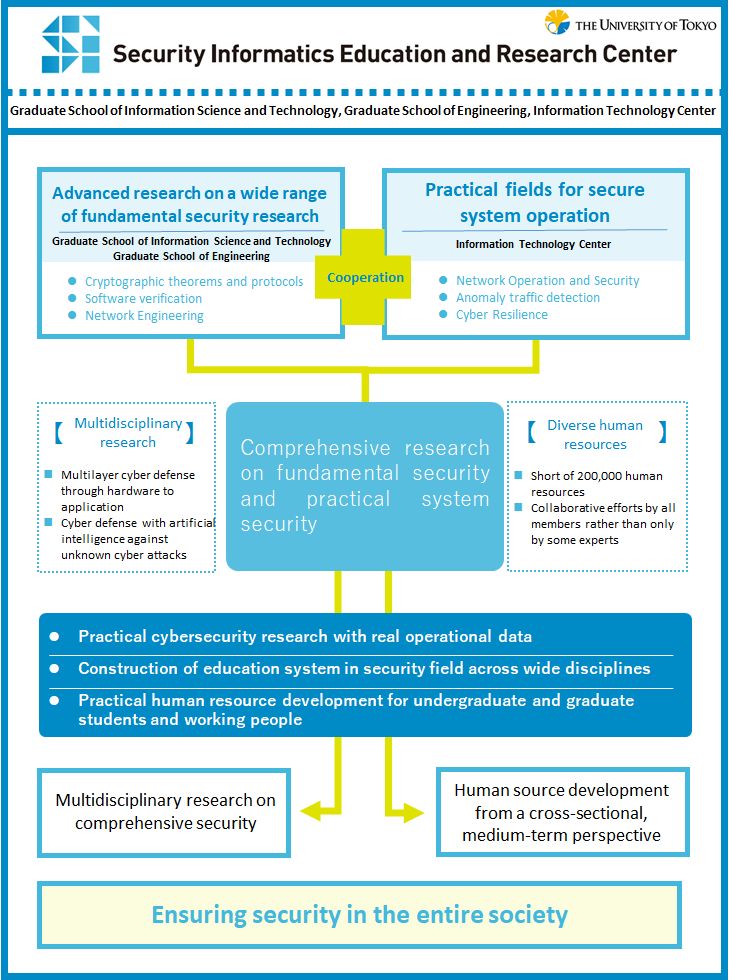We work on cybersecurity education and research. Cybersecurity is a urgent issue for our IT society, there has been many successful research on technologies to respond to cyber threats. Despite of it, cyber attacks and the amont loss caused by the attacks are still increasing. In order to protect and mitigate new cyber attacks, it is no longer sufficient for some experts to ensure cybersecurity, but all stakeholders to work together to implement multilayer cyber defenses. To that end, it is also necessary to develop human resources from a cross-sectional, medium- and long-term perspective. However, comprehensive and systematic efforts to ensure cybersecurity are not yet sufficient.
Security Informatics Education and Research Center was established on the 1st of February, 2019, by the collabolation among Graduate School of Information and Science and Technology (a responsible division), Graduate School of Engineering, and Information and Technology Center, the University of Tokyo.
Our mission is to improve advanced research and education for information security, by the comprehensive research on practical cybersecurity for real systems and security fundamental technologies studied in the academic research field. We will promote the development of a comprehensive information security education system and the development of human resources who will be responsible for the next generation.
Message from the Director

Professor
Graduate School of Information Science and Technology
Center for Education and Research in Information Science and Technology
In modern society, the rapid advancement of IT and AI technologies is driving IT integration and efficiency across various fields, aiming to realize a more advanced IT society. Under these circumstances, society is increasingly dependent on digital technologies, and along with this dependence, new cyber threats and attack risks are also increasing. Cyberattacks are becoming more sophisticated and diverse, causing serious impacts such as personal information leaks, corporate secret theft, and attacks on infrastructure. Implementing effective cybersecurity measures against these cyber threats is extremely important to ensure the safety and reliability of society as a whole.
Recent cyberattacks vividly illustrate the severity of the threats we face. For example, the 2017 WannaCry ransomware attack targeted many companies, government agencies, and hospitals worldwide, causing extensive damage. Subsequently, the damage caused by ransomware attacks has continued to increase, resulting in large-scale system failures and information leaks in many companies and organizations both domestically and internationally. Additionally, there have been instances where malicious code was embedded in open-source software used globally, exposing vulnerabilities in the software supply process itself. Supply chain attacks on software are particularly challenging to detect as they infiltrate systems indirectly through trusted software and services, and their impact is immense. These cases demonstrate that cyberattacks can significantly affect the entire social system.
Moreover, the importance of new cybersecurity measures such as active defense and security by design is increasing. Security by design involves incorporating security measures from the design stage of products and systems. By integrating vulnerability checks for system workflows and software supply chain risks from the design stage, proactive cybersecurity measures can prevent damage before it occurs.
Thus, cybersecurity measures are diversifying, and strengthening and promoting these measures is essential to protect our lives and social safety. Critical challenges in future cybersecurity measures include the development of technologies that can quickly respond to new threats and the cultivation of personnel with specialized cybersecurity knowledge and skills across various fields.
The SI Center is contributing to the research and development of “Security DX” technologies that assist security from the user’s perspective, as well as to the cultivation of security personnel to protect the future IT society. One example is the cross-departmental educational program “Cybersecurity Education Program,” launched in 2022, which offers a comprehensive curriculum covering the understanding of basic IT technologies necessary for cybersecurity measures, application methods to systems, system construction and operation as social infrastructure, and the formation of security systems within organizations. The SI Center will continue to deepen collaboration with private companies and government agencies, aiming to enhance the overall security level of society through the research and development of Security DX technologies and the cultivation of security personnel, thereby contributing to the improvement of safety in social life and social infrastructure.
Key Concept

logo

The logo shows the two words, “S” and “I”, from Security Informatics education and research center.
It consists of nine parts of different shapes and colors, but each can only be properly oriented and positioned to represent SI. We hope that we want to ensure cyber security in the entire society by coordinating and collaborating while all actors play appropriate roles.